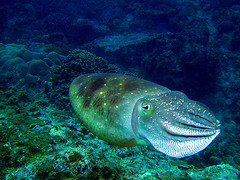Our color vision is based on three different types of visual pigments. This is called trichromacy and as a matter of fact, it is quite unusual in the animal kingdom.
The following information is a compilation of the article Color Vision: How Our Eyes Reflect Primate Evolution.
Animals have either only one visual pigment, like a few nocturnal mammals. Or they are dichromats, which means they have two different pigment types. This is true for almost all mammals—except the primates, which are most often trichromats. And some birds, fish and reptiles even have four different types which makes them sensitive also for ultraviolet light sources.
The questions arises now: How comes that we are trichromats?
1st step: It looks like that the short-wavelength (S) pigments are the most ancient ones, as they are found in almost all vertebrates.
2nd step: Similar forms to our medium- (M) and long-wavelength (L) pigments are also found quite often—and therefore very old. But only a few primates have both of them, so this has to be a recent evolution.
3rd step: Let’s say the M pigment existed (we actually don’t know). And then through some mutation of a few acids in the DNA the L pigment evolved. Now a first interesting step happened: Some female primates inherited one X chromosome encoding the M pigment and one X chromosome the L pigment and they became thrichromats! This way only female primates could be trichromats as only they have two X chromosomes (male = XY).
4th step: Now the New World primates evolved away from Old World primates. They still are carrying the information encoding color vision as described above. But in the lineage of Old World primates a next interesting development happened: A female primate merged the M and L encoding into one single X chromosome through mutation! This way also male primates became trichromats (thanks!).
5th step: This genetic mutation had such a strong advantage (seeing more colors = finding more good food) that X chromosomes encoding only one pigment were wiped out of the genetic pool.
This five steps of the evolution of color vision sound very interesting. But there are also some questions which arise when reading through, which make me think that we didn’t get to the bottom of it yet. Here are my questions:
- How comes that our ancestors suddenly could see the new colors only because of a new pigment type?
- Can really only one female primate be the source of our trichromatic vision?
- And why the hack are there still so many color blind people? Why is color vision deficiency in so many forms still that widespread?
The authors of Color Vision: How Our Eyes Reflect Primate Evolution have some answers ready. But I’m not sure if I can believe what they are writing.
And there is still no answer for my most important question. Maybe you have one? — Why is color blindness still such a common disease?

